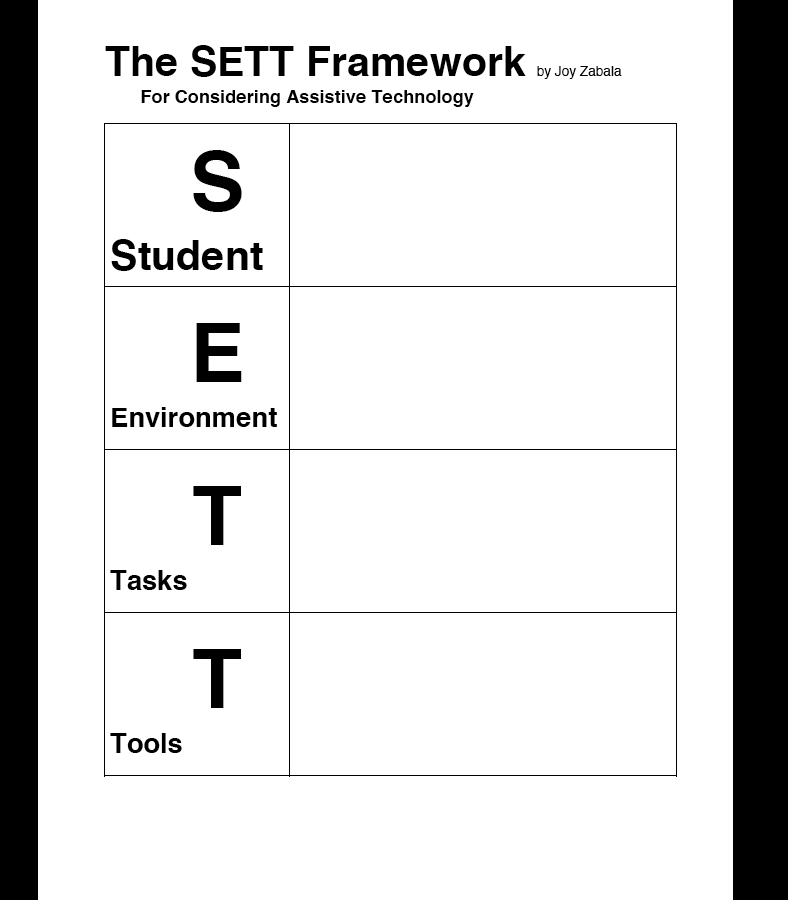If the IEP team determines that the student needs AT to access and participate in the school environment, and more information is needed then the AT Assessment process is initiated.
The purpose of having an assistive technology assessment is to "identify technology options that will accommodate the needs of students with disabilities. Such options should increase, improve, or maintain student functioning in educational, vocational, and community environments" (Assistive Technology Internet Modules).
When beginning the AT assessment process, the IEP needs to consider:
 1) the student, the student's environment and the tasks the student can accomplish independently if provided with AT.
1) the student, the student's environment and the tasks the student can accomplish independently if provided with AT.
2) Next, identify the student's strengths.
3) The SETT (Student, Environment, Tasks, and Tools) framework is very helpful in this process. "The SETT framework helps teams gather information about a student's strengths, skills, and challenges" (). All of the above aspects need to be considered before the IEP can consider AT.
What Is The Next Step?:
- The IEP team should now begin to look for AT options that would be most effective by first looking at the student's needs.
- Once desired features have been identified, the team needs to discuss solutions that are available at home or at school and see if their features match the student's needs.
Guidance To Help Choose AT:
- Assessing Student's Needs for Assistive Technology (ASNAT) organizes information by AT categories (example: AT for communication) to help guide the team to identify features that will address student needs.
- TechMatrix is a website that "allows users to identify potential AT solutions by creating a customized search based on the selected features. This website is specifically developed for finding technology options for students with special needs" (Assistive Technology Internet Modules)Assistive Technology Internet Modules. Once users have clicked on the SEARCH tab, they are able to refine the number of resources based on content area, grade level, role, learning support, accessibility features, NES Standards and Tech Specs
What Happens After AT Is Chosen?:
- The team should have the student try the technology first.
- During this trial, data should be collected to determine its effectiveness.
- Next, the team looks over the data and comes to a decision about using the AT and how it is going to be purchased.
- Once purchased, the AT needs to be implemented. The IEP team must make up a plan that involves training, environmental considerations, ongoing evaluation and the roles and responsibilities of the team members during implementation of the AT.
- Progress monitoring should be done on the AT. "Progress monitoring is a scientifically based practice that is used to assess students' academic performance and evaluate the effectiveness of instruction" (Assistive Technology Internet Modules).
- Also consider transition planning for the student.
How Does This Relate To The Classroom?:
As educators, it is our responsibility that all of our students can succeed in the classroom. You are going to be responsible for helping an IEP team decide whether or not an AT device would help a student succeed in the classroom and if so, which device would be the most appropriate!
I never realized how simple the AT process really can be! When an IEP team works together to think about the student's specific needs and how AT can help them become more independent in the classroom, the process can be quite easy! The process becomes especially easy when educators have ASNAT and TechMatrix to help them find the most appropriate AT!!!
Assistive Technology Internet Modules. (2013). AT For School Age. Retrieved from: http://www.atinternetmodules.org/mod_view.php?nav_id=1440.

No comments:
Post a Comment